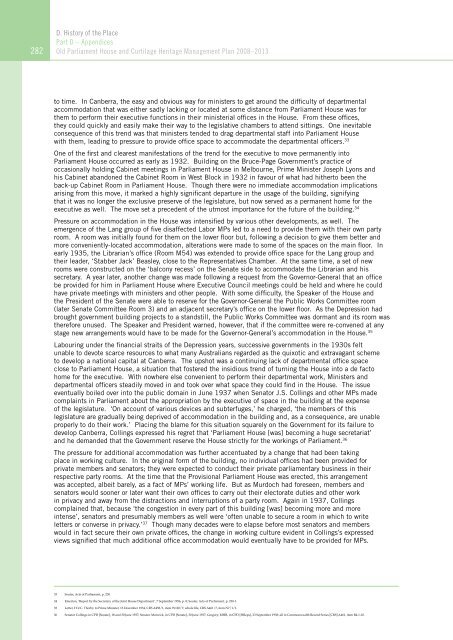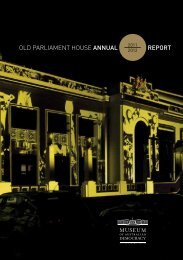OLD PARLIAMENT HOUSE AND CURTILAGE HERITAGE MANAGEMENT PLAN 2008–2013
Heritage Management Plan 2008-2013 - Museum of Australian ...
Heritage Management Plan 2008-2013 - Museum of Australian ...
- No tags were found...
Create successful ePaper yourself
Turn your PDF publications into a flip-book with our unique Google optimized e-Paper software.
D. History of the Place<br />
Part D – Appendices<br />
282 Old Parliament House and Curtilage Heritage Management Plan <strong>2008–2013</strong><br />
to time. In Canberra, the easy and obvious way for ministers to get around the difficulty of departmental<br />
accommodation that was either sadly lacking or located at some distance from Parliament House was for<br />
them to perform their executive functions in their ministerial offices in the House. From these offices,<br />
they could quickly and easily make their way to the legislative chambers to attend sittings. One inevitable<br />
consequence of this trend was that ministers tended to drag departmental staff into Parliament House<br />
with them, leading to pressure to provide office space to accommodate the departmental officers. 33<br />
One of the first and clearest manifestations of the trend for the executive to move permanently into<br />
Parliament House occurred as early as 1932. Building on the Bruce-Page Government’s practice of<br />
occasionally holding Cabinet meetings in Parliament House in Melbourne, Prime Minister Joseph Lyons and<br />
his Cabinet abandoned the Cabinet Room in West Block in 1932 in favour of what had hitherto been the<br />
back-up Cabinet Room in Parliament House. Though there were no immediate accommodation implications<br />
arising from this move, it marked a highly significant departure in the usage of the building, signifying<br />
that it was no longer the exclusive preserve of the legislature, but now served as a permanent home for the<br />
executive as well. The move set a precedent of the utmost importance for the future of the building. 34<br />
Pressure on accommodation in the House was intensified by various other developments, as well. The<br />
emergence of the Lang group of five disaffected Labor MPs led to a need to provide them with their own party<br />
room. A room was initially found for them on the lower floor but, following a decision to give them better and<br />
more conveniently-located accommodation, alterations were made to some of the spaces on the main floor. In<br />
early 1935, the Librarian’s office (Room M54) was extended to provide office space for the Lang group and<br />
their leader, ‘Stabber Jack’ Beasley, close to the Representatives Chamber. At the same time, a set of new<br />
rooms were constructed on the ‘balcony recess’ on the Senate side to accommodate the Librarian and his<br />
secretary. A year later, another change was made following a request from the Governor-General that an office<br />
be provided for him in Parliament House where Executive Council meetings could be held and where he could<br />
have private meetings with ministers and other people. With some difficulty, the Speaker of the House and<br />
the President of the Senate were able to reserve for the Governor-General the Public Works Committee room<br />
(later Senate Committee Room 3) and an adjacent secretary’s office on the lower floor. As the Depression had<br />
brought government building projects to a standstill, the Public Works Committee was dormant and its room was<br />
therefore unused. The Speaker and President warned, however, that if the committee were re-convened at any<br />
stage new arrangements would have to be made for the Governor-General’s accommodation in the House. 35<br />
Labouring under the financial straits of the Depression years, successive governments in the 1930s felt<br />
unable to devote scarce resources to what many Australians regarded as the quixotic and extravagant scheme<br />
to develop a national capital at Canberra. The upshot was a continuing lack of departmental office space<br />
close to Parliament House, a situation that fostered the insidious trend of turning the House into a de facto<br />
home for the executive. With nowhere else convenient to perform their departmental work, Ministers and<br />
departmental officers steadily moved in and took over what space they could find in the House. The issue<br />
eventually boiled over into the public domain in June 1937 when Senator J.S. Collings and other MPs made<br />
complaints in Parliament about the appropriation by the executive of space in the building at the expense<br />
of the legislature. ‘On account of various devices and subterfuges,’ he charged, ‘the members of this<br />
legislature are gradually being deprived of accommodation in the building and, as a consequence, are unable<br />
properly to do their work.’ Placing the blame for this situation squarely on the Government for its failure to<br />
develop Canberra, Collings expressed his regret that ‘Parliament House [was] becoming a huge secretariat’<br />
and he demanded that the Government reserve the House strictly for the workings of Parliament. 36<br />
The pressure for additional accommodation was further accentuated by a change that had been taking<br />
place in working culture. In the original form of the building, no individual offices had been provided for<br />
private members and senators; they were expected to conduct their private parliamentary business in their<br />
respective party rooms. At the time that the Provisional Parliament House was erected, this arrangement<br />
was accepted, albeit barely, as a fact of MPs’ working life. But as Murdoch had foreseen, members and<br />
senators would sooner or later want their own offices to carry out their electorate duties and other work<br />
in privacy and away from the distractions and interruptions of a party room. Again in 1937, Collings<br />
complained that, because ‘the congestion in every part of this building [was] becoming more and more<br />
intense’, senators and presumably members as well were ‘often unable to secure a room in which to write<br />
letters or converse in privacy.’ 37 Though many decades were to elapse before most senators and members<br />
would in fact secure their own private offices, the change in working culture evident in Collings’s expressed<br />
views signified that much additional office accommodation would eventually have to be provided for MPs.<br />
33 Souter, Acts of Parliament, p. 230.<br />
34 Emerton, ‘Report by the Secretary of the Joint House Department’, 7 September 1956, p. 8; Souter, Acts of Parliament, p. 230-1.<br />
35 Letter, H.V.C. Thorby to Prime Minister, 13 December 1934, CRS A458/1, item W120/7; whole file, CRS A461/7, item N7/1/1.<br />
36 Senator Collings in CPD [Senate], 18 and 30 June 1937; Senator Marwick, in CPD [Senate], 30 June 1937; Gregory, MHR, in CPD [HReps], 23 September 1938; all in Commonwealth Record Series [CRS] A461, item B4-1-10.




